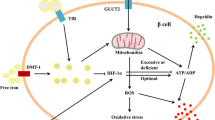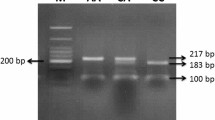Abstract
To assess the relationship between the length of (GT) n repeats in HO-1 gene promoter and heme oxygenase (HO) enzymatic activity in mononuclear cells with iron (Fe) stores in type 2 diabetic mellitus (DM2) patients and metabolic syndrome (MS) subjects, we studied 163 patients with DM2, 185 with MS, and 120 controls subjects. We evaluated iron status (hemoglobin and serum Fe, ferritin, and transferrin receptor), and we determined the length of (GT) n repeats in HO-1 gene promoter by capillary electrophoresis and HO enzymatic activity in mononuclear cells and assessed the relationship between these results and Fe stores. Only 1/163, 6/185, and 7/120 had iron deficiency anemia in DM2 patients, MS subjects, and controls, respectively. No iron overload (ferritin >200 μg/L) was detected in all the subjects studied. DM2 patients had higher iron deposits, total body iron, and heme oxygenase activity (a suggestion of high oxidative stress condition) than MS subjects and controls. In DM2, we found a positive association between serum iron and HO activity. There were no difference in allelic frequency between the three groups; however, among DM2 and MS patients, the frequency of short/medium (SM) genotype of (GT) n repetition was increased and medium/medium (MM) genotype of (GT) n repetition was lower than controls. These results imply that DM2 patients and individuals with MS carrying SM repeats might have higher susceptibility to develop diabetes consequences. This increased susceptibility could be Fe-mediated oxidative stress.

Similar content being viewed by others
References
Bustos P, Da Silva AA, Amigo H, Bettiol BMA (2007) Metabolic syndrome in young adults from two socioeconomic Latin American settings. Nutr Metab Cardiovasc Dis 17:581–589
Leiva E, Mujica V, Elematore I, Orrego R, Diaz G, Prieto M, Arredondo M (2007) Relationship between Apolipoprotein E polymorphism and nephropathy in type-2 diabetic patients. Diabetes Res Clin Pract 78:196–201
Avery CL, Freedman BI, Kraja AT, Borecki IB, Miller MB, Pankow JS, Arnett D, Lewis CE, Myers RH, Hunt SC, North KE (2006) Genotype-by-sex interaction in the aetiology of type 2 diabetes mellitus: support for sex-specific quantitative trait loci in Hypertension Genetic Epidemiology Network participants. Diabetologia 49:2329–2336
Witte DL, Crosby WH, Edwards CQ, Fairbanks VF, Mitros FA (1996) Practice guideline development task force of the College of American Pathologists. Hereditary hemochromatosis. Clin Chim Acta 245:139–200
Alissa EM, Ahmed WH, Al-Ama N, Ferns GA (2007) Relationship between indices of iron status and coronary risk factors including diabetes and the metabolic syndrome in Saudi subjects without overt coronary disease. J Trace Elem Med Biol 21:242–254
Olusegun A, Mojiminiyi OA, Marouf R, Abdella NA (2007) Body iron stores in relation to the metabolic syndrome, glycemic control and complications in female patients with type 2 diabetes. Nutr Metab Cardiovasc Dis. doi:10.1016/j.numecd.2007.07.007
Jiang R, Manson JE, Meigs JB, Ma J, Rifai N, Hu FB (2004) Body iron stores in relation to risk of type 2 diabetes in apparently healthy women. JAMA 291:711–717
Arredondo M, Jorquera D, Carrasco E, Albala C, Hertrampf E (2007) Microsatellite polymorphism in the heme oxygenase-1 gene promoter is associated with iron status in persons with type 2 diabetes mellitus. Am J Clin Nutr 86:1347–1353
Dandona P, Thusu K, Cook S, Snyder B, Makowski J, Armstrong D, Nicotera T (1996) Oxidative damage to DNA in diabetes mellitus. Lancet 347:444–445
Giugliano D, Ceriello A, Paolisso G (1996) Oxidative stress and diabetic vascular complications. Diabetes Care 19:257–267
Laybutt DR, Kaneto H, Hasenkamp W, Grey S, Jonas JC, Sgroi DC, Groff A, Ferran C, Bonner-Weir S, Sharma A, Weir GC (2002) Increased expression of antioxidant and antiapoptotic genes in islets that may contribute to beta-cell survival during chronic hyperglycemia. Diabetes 51:413–423
Lavrovsky Y, Schwartzman ML, Levere RD, Kappas A, Abraham NG (1994) Identification of binding sites for transcription factors NF-kappa B and AP-2 in the promoter region of the human heme oxygenase 1 gene. Proc Natl Acad Sci 91:5987–5991
Naylor LH, Clark EM (1990) d(TG) n /d(CA) n sequences upstream of the rat prolactin gene form Z-DNA and inhibit gene transcription. Nucleic Acids Res 18:1595–1601
Yamada N, Yamaya M, Okinaga S, Nakayama K, Sekizawa K, Shibahara S, Sasaki H (2000) Microsatellite polymorphism in the heme oxygenase-1 gene promoter is associated with susceptibility to emphysema. Am J Hum Genet 66:187–195
American Diabetes Association (2009) Standards of medical care in diabetes-2009. Diabetes Care 32(1):S13–S61
National Cholesterol education Program (2005) Detection, evaluation and treatment of high blood colesterol in adults (adult treatment panel III). NIH Publications Nº 02-5215
Ford E, Cogswell ME (1999) Diabetes and serum ferritin concentration among U.S. adults. Diabetes Care 22:1978–1983
Wrede CE, Buettner R, Bollheimer LC, Scholmerich J, Palitzsch KD, Hellerbrand C (2006) Association between serum ferritin and the insulin resistance syndrome in a representative population. Eur J Endocrinol 154:333–340
Wood RJ (2001) Iron status of the free-living, elderly Framingahm heart study cohort: an iron-replete population with a high prevalence of elevated iron status. Am J Clin Nutr 73:638–646
Hu F, Meigs JB, Li T, Rifai N, Manson JE (2004) Inflamatory markersand risk of developing type 2 diabetes in women. Diabetes 53:693–700
Chen YH, Lin SJ, Lin MW, Tsai HL, Kuo SS, Chen JW, Charng MJ, Wu TC, Chen LC, Ding YA, Pan WH, Jou YS, Chau LY (2002) Microsatellite polymorphism in promoter of heme oxygenase-1 gene is associated with susceptibility to coronary artery disease in type 2 diabetic patients. Hum Genet 111:1–8
Hirai H, Kubo H, Yamaya M, Nakayama K, Numasaki M, Kobayashi S, Suzuki S, Shibahara S, Sasaki H (2003) Microsatellite polymorphism in heme oxygenase-1 gene promoter is associated with susceptibility to oxidant induced apoptosis in lymphoblastoid cell lines. Blood 102:1619–1621
Okinaga S, Takahashi K, Takeda K, Yoshizawa M, Fujita H, Sasaki H, Shibahara S (1996) Regulation of human heme oxygenase-1 gene expression under thermal stress. Blood 87:5074–5084
Arredondo M, Kloosterman J, Núñez S, Segovia F, Candia V, Flores S, Le Blanc S, Olivares M, Pizarro F (2008) Heme iron uptake by Caco-2 cells is a saturable, temperature sensitive and modulated by extracellular pH and potassium. Biol Trace Elem Res 125:109–11924
Cosso L, Maineri EP, Traverso N, Rosatto N, Pronzato MA, Cottalasso D, Marinari UM, Odetti P (2001) Induction of heme oxygenase 1 in liver of spontaneously diabetic rats. Free Radic Res 34:189–191
Acknowledgements
We thank the staff from the Diabetic Program, Nutrition Unit, of Juan de Dios Hospital, for their teamwork and persistent efforts in this project.
This work was supported by Fondo Nacional de Ciencia y Tecnología (FONDECYT) grant # 1051006 and 1085173, Chile.
The authors' responsibilities were as follows—MA: study design, management of laboratory work, data collection, analysis, and interpretation and writing of the manuscripts; DJ, MF, and VC: laboratory analysis, data collection, analysis, and interpretation; EH: study design, management of hematological patients, revision of the manuscripts; EC: management of the field site, sample collection, revision of the manuscripts; and CA: study design, management of diabetics patients, and revision of the manuscripts. None of the authors had a personal or financial conflict of interest.
Author information
Authors and Affiliations
Corresponding author
Rights and permissions
About this article
Cite this article
Arredondo, M., Fuentes, M., Jorquera, D. et al. Cross-Talk Between Body Iron Stores and Diabetes: Iron Stores are Associated with Activity and Microsatellite Polymorphism of the Heme Oxygenase and Type 2 Diabetes. Biol Trace Elem Res 143, 625–636 (2011). https://doi.org/10.1007/s12011-010-8895-7
Received:
Accepted:
Published:
Issue Date:
DOI: https://doi.org/10.1007/s12011-010-8895-7




